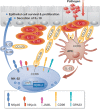Hidden talents of natural killers: NK cells in innate and adaptive immunity
- PMID: 19730434
- PMCID: PMC2759738
- DOI: 10.1038/embor.2009.203
Hidden talents of natural killers: NK cells in innate and adaptive immunity
Abstract
Natural killer (NK) cells are innate immune lymphocytes capable of killing target cells and producing immunoregulatory cytokines. Herein, we discuss recent studies that indicate that NK cells span the conventional boundaries between innate and adaptive immunity. For example, it was recently discovered that NK cells have the capacity for memory-like responses, a property that was previously thought to be limited to adaptive immunity. NK cells have also been identified in multiple tissues, and a subset of cells that specialize in the production of the T(H)17 cytokine IL-22, NK-22s, was recently described in mucosal-associated lymphoid tissue. Finally, we review work that shows that NK cells develop at sites that were traditionally thought to be occupied only by adaptive immune cells, including the thymus and lymph nodes.
Figures






References
-
- Agaugue S, Marcenaro E, Ferranti B, Moretta L, Moretta A (2008) Human natural killer cells exposed to IL-2, IL-12, IL-18, or IL-4 differently modulate priming of naive T cells by monocyte-derived dendritic cells. Blood 112: 1776–1783 - PubMed
-
- Andrews DM, Scalzo AA, Yokoyama WM, Smyth MJ, Degli-Esposti MA (2003) Functional interactions between dendritic cells and NK cells during viral infection. Nat Immunol 4: 175–181 - PubMed
-
- Arase H, Mocarski ES, Campbell AE, Hill AB, Lanier LL (2002) Direct recognition of cytomegalovirus by activating and inhibitory NK cell receptors. Science 296: 1323–1326 - PubMed
-
- Aujla SJ, Kolls JK (2009) IL-22: a critical mediator in mucosal host defense. J Mol Med 87: 451–454 - PubMed
-
- Biron CA, Byron KS, Sullivan JL (1989) Severe herpesvirus infections in an adolescent without natural killer cells. N Engl J Med 320: 1731–1735 - PubMed
Publication types
MeSH terms
Grants and funding
- R01 AI034385/AI/NIAID NIH HHS/United States
- R37 AI034385/AI/NIAID NIH HHS/United States
- R01 AI033903/AI/NIAID NIH HHS/United States
- AI 33903/AI/NIAID NIH HHS/United States
- AI 34385/AI/NIAID NIH HHS/United States
- P30 AR048335/AR/NIAMS NIH HHS/United States
- T32 HD043010/HD/NICHD NIH HHS/United States
- AR 48335/AR/NIAMS NIH HHS/United States
- AI 51345/AI/NIAID NIH HHS/United States
- HHMI/Howard Hughes Medical Institute/United States
- AI 57160/AI/NIAID NIH HHS/United States
- U54 AI057160/AI/NIAID NIH HHS/United States
- R01 AI051345/AI/NIAID NIH HHS/United States
LinkOut - more resources
Full Text Sources

